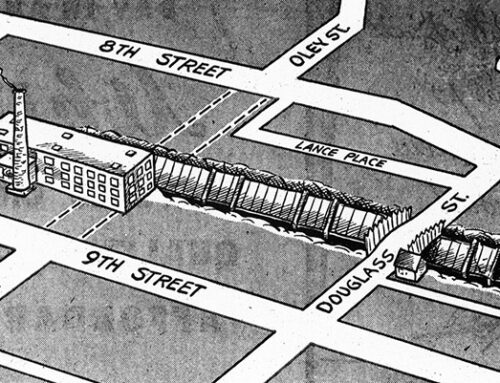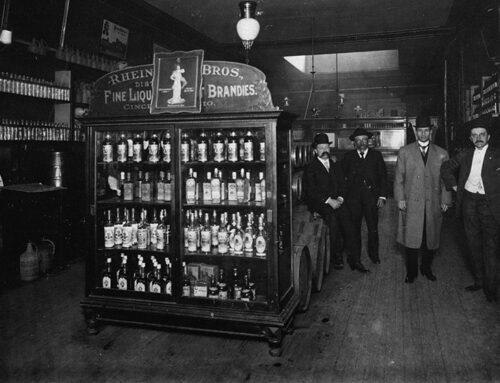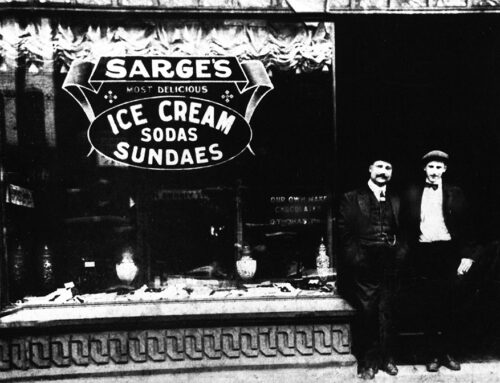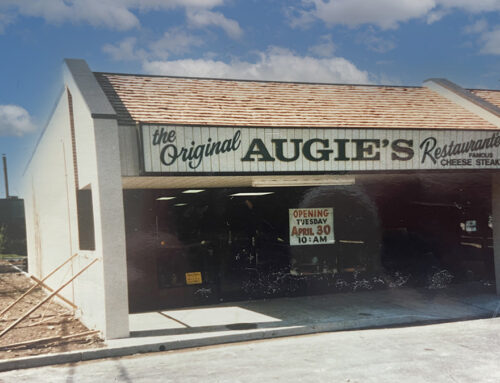In 1890, observing that the braiding industry had rapidly developed in the United States during the last 20 years of the 19″‘ century, Ferdinand Thun and Henry Janssen rented a suitable brick building, at 222 Cedar Street, Reading for a modest $40.00 per month and began assembling the first American full-fashioned knitting machine.
Below: Ferdinand Thun and Henry Janssen, about 1892.

Below: Birthplace of the Textile Machine Works – 222 Cedar Street, Reading. Occupied by the firm from 1892 to 1896.

With the firm name of Thun & Janssen there appeared a descriptive subtitle that allowed the young partners wide latitude; it read: “Textile Machine Works.” On July 5, 1892, the door was opened.
Thun & Janssen were primarily focused on machinery to make decorative braid & trimming for clothing, however they also offered industrial machines to produce braided covering (insulation) of electrical wire and other specialty purposes.
The men were not initially successful in competing with the established German equipment manufacturers and therefore they began by repairing existing machinery.
In 1895, Thun & Janssen received their first large order for new machinery. As a result, the firm of Thun & Janssen moved to a new and larger facility in Wyomissing in September of 1896 and was later incorporated on August 14, 1900, as the “Textile Machine Works.” Development was being encouraged during this period and the land, strategically located next to the railroad, was obtained for the sum of $1.00.
At the turn of the century, braiding machinery was primarily used to create both decorative braid for clothing and brush braid on the hems of ladies skirts. Braid was in high demand and the supply was limited, therefore the founders made a decision to begin using their own machinery for production, and on January 2nd, 1900, the second of the three Wyomissing Industries businesses was incorporated as the “Narrow Fabric Company.”
During the 1880s and 1890s, the efforts of Thomas Edison and Nikola Tesla launched the electrical age.
In the early 1900s, shortly after the dawn of the electrical age, the demand for insulated wire, cable and other industrial applications for cloth braiding increased rapidly. By mid-1903, industrial braiding machines for such applications furnished most of the Textile Machine Works’ business. At the same time this was occurring, the demand for machinery to make decorative braid was proportionally declining.
On December 7, 1899, an event of great significance occurred. The Nolde & Horst hosiery mill in Reading burned to the ground, however some of the machinery was considered salvageable. The firm of Thun & Janssen was contracted to repair the existing German made full-fashioned hosiery machines.
As a result of the Nolde & Horst fire, the founders began speculating on whether or not they might be able to compete with the established full-fashioned hosiery machine manufacturers in Germany. They envision design improvements.
At this time it seemed like a long shot due to the fact that ladies skirts still brushed the floor. Nevertheless, by mid-1900 the first experimental machine was assembled in the shop.
The first full-fashioned knitting machines, made in the United States, were sold to a firm in Nazareth, PA, thereby providing some limited incentive. Once again the founders made a decision to begin using their own machinery and on July 12, 1906, the last of the three primary Wyomissing Industries businesses was incorporated as the “Berkshire Knitting Mills.”
Prior to 1907 only 8 full-fashioned knitting machines had been sold. The founders were discouraged by this and seriously considered discontinuing this effort.
In 1908 ladies skirts began to rise and glimpses of the ankle could now be seen. Silk became the material of choice for stockings. Prior to this, ladies wore mostly cotton socks.
In 1913, just before World War I, hemlines began to rise rapidly. Having previously established themselves in an ideal position, the founders were poised for unimaginable success. By the end of 1913 they were producing over 100 full-fashioned machines per year.
After World War I hemlines continued to rise, especially during the Roaring 20s. In 1926 annual production hit 1000 machines and by 1932 roughly 10,000 machines were being used in the United States.
Below: Millions of visitors to the Chicago “Century of Progress” marveled at the work of the “Reading” Full-Fashioned Machine.

Prior to World War II, the famous “Reading” Full Fashioned Knitting Machine was actually two separate machines. One machine knitted the legs of the stockings and the other knitted the feet.
During World War II, while all production was being utilized for the war effort, the Textile Machine Works used this time to design the “Reading 80” and “Reading 100” machines. These knitted both the leg and foot of the stocking as one continuous unit.
One of several factors in the postwar decline of the Wyomissing Industries was a temporary loss of vision for the future. The founders were now in their 70s and had naturally become somewhat resistant to change.
In the late 1930s, DuPont introduced a revolutionary new fiber, known to the world as Nylon. The Wyomissing Industries were approached by DuPont and asked to assist in testing the new material, but they were slow to respond and did realize the full impact that this discovery would have on the industry.
Almost immediately after WWII, the trend in fashion began to change from full-fashioned stockings, made on flat bed knitting machines, to seamless Nylon stockings (Nylons), made on circular knitting machines. The Industries did not respond in a timely manner, however they later acquired circular technology in the mid-1950s and began the slow process of recovery.
By the late 1960s, two decades after the founders had passed, the times had changed, both socially and economically. It would have been very difficult to adapt to these dramatic changes. Additionally, many of the family members were no longer active in the business on a day to day basis.
The Textile Machine Works was sold to Rockwell International, who planned to continue in this business. The Janssen’s purchased the Thun families share of Berkshire International. Shortly thereafter, however, they sold Berkshire to the Vanity Fair Corporation.
In 1970, M.O. Lee, then-president of VF Corp., suggested holding a sale one Saturday morning at the company’s Berkshire Knitting Mill in Wyomissing to get rid of excess Berkshire International inventory. The sale was a smashing success, so a bigger sale was scheduled for two weeks later. That one was an even bigger hit. As a result, a factory store was opened to sell Berkshire and Vanity Fair surplus products. The factory store eventually grew to an outlet center – the first of its kind in the country.
In 2001, the VF Outlet Center was still getting an estimated 5 million visitors a year. That year it was voted the top U.S. shopping destination by the American Bus Association, with about 6,000 buses traveling to the center in a year. With more outlet centers opening in other places the VF Outlet Center became less of a regional draw.
In December 2016, affiliates of Equus Capital Partners, Ltd. acquired the Vanity Fair Outlet Center (53 acres) on the site of the former Berkshire Knitting Mills campus (100+ acres). The Knitting Mills (TKM) is a 53-acre mixed-use development situated near the intersection of Penn Ave. (Rt. 422) and Park Rd., in Wyomissing, Berks County, Pennsylvania.
At its peak, from the 1920s through the 1950s, the Berkshire Knitting Mills made more women’s full-fashioned stockings than any other plant in the world. The knitting mills and related textile operations formed the backbone of the early development of Wyomissing, which has since become a regional hub of business activity. The borough still thrives long after it ceased to be a center of industry.
The Knitting Mills represented a unique opportunity in terms of its iconic setting, historic architecture, and unparalleled access to amenities including parks, recreation, museums, housing, and medical services. Unlike other corporate campuses, The Knitting Mills began as a planned community. Ferdinand Thun and Henry Janssen the visionaries who created the Berkshire Knitting Mills at the beginning of the 19th century, wanted to create a safe, clean, orderly community for employees, management, and ownership.
Over the last 4 years, The Knitting Mills has reemerged as the premier corporate headquarters and innovation center in Berks County. It is now home to UGI’s Energy Services HQ, Tower Health’s Corporate Offices and Training Center, Teleflex/ Arrow’s R&D and Innovation Center and Drexel University College of Medicine at Tower Health. On site amenities include McDonalds, WaWa and Sly Fox Brew Pub. It is flanked by the county’s outstanding multifamily developments Wyomissing Sq. (230 units) including and The Narrows (90 units) and is within a 5 minute walk of West Reading’s Main Street District, offering a unique variety of small shops, restaurants, services and housing. In addition, The Knitting Mills is within walking distance of Berks’ Counties wealthiest community Wyomissing Borough and the area’s largest and most dynamic employer, Reading Hospital / Tower Health Systems.
HOW THE BERKSHIRE ‘ ‘FOLLOWS THROUGH’

Every week the Berkshire Knitting Mills convert a dozen tons of silk into something like 400,000 pairs of full-fashioned stockings for the women of America.
To accomplish this efficiently, speedily and perfectly, a continuous flow of work must follow naturally and logically from the first to the last operation.
The system of work flow in our mill is most unique. The layout and sequence of operations have been so thoroughly planned that the progress of the raw material from the raw silk to the finished stocking is amazingly simple, short, smooth and rapid.
The drawing shows the mill as being of three great units—two groups of buildings being the knitting units where the stockings, leg and foot, are knitted; the third group, the finishing unit, where all operations exclusive of knitting are done.
Raw silk, cotton yarn and synthetic fibers—the raw materials— are received on the first floor at the north end of Building 201. They come from the throwster already placed on cones ready for use. Before going to the knitting floors, the silk is taken to the conditioning or humidifying room where it is kept for a number of hours to give it a moisture content proper for knitting. Only a negligible amount of silk – everything over seven thread – finds its way to the winding room at the north end of the second floor of Building 202. In either case the conditioned cones are then taken to the legging department to begin the first manufacturing operation – the knitting of the leg of the stocking.
Legging departments occupy the third, fourth and fifth floors of Buildings 101, 102, 103, 201 and 202. Footing and topping departments occupy the second floor of the same buildings. It takes about three times as long to knit the leg as the foot of a stocking, consequently there are three floors of leggers to one of footers. With three floors of leggers above one floor of footers, it is very convenient to have all the legs for the three upper legging floors footed on the ground floor and the natural sequence of the completed leg is therefore downward to the footing department.
After the legging and footing operations the knitting operations are completed. The stockings, flat, nondescript-appearing objects, are conveyed on rubber-tired, covered hand trucks to the finishing buildings.
The initial operations in the finishing process are done in the looping and seaming departments on the second floor of Buildings 105 and 108. First the heel and toe are closed in the looping department and then the unlooped edges of the stockings are joined in the seaming department. The loopers and seamers are arranged in aisles on opposite sides of the same room so that a minimum of handling is involved in transporting the stockings from the looping to the seaming departments.
So far no mention has been made of inspection. The reason is that in the Berkshire inspection is a continuous operation which follows the flow of work from start to finish. There are, however, some departments devoted exclusively to inspection. Thus immediately after the looping and seaming operation the work goes to the floor above where the examining and mending is done. Here the stockings are minutely examined and repaired by skilled menders with a specially constructed hook used to pick up dropped stitches.
All stockings are knit “in the grey” or without being dyed and in that condition they are sent to the grey stock rooms on the fourth floor of Building 108 to await the dyeing operation.
You will have noticed that in the knitting processes the raw material moved downward to be completed, but upon entering the finishing buildings the stockings move upward to the grey stock rooms.
The reason for this is that they are moving in the direction of the next operation, dyeing, which department is located directly across from the dye lot assembly department on the fifth floor of Building 105.
The dye house is the only one we know of in the world located on the top floor of a mill. Revolutionary in location and construction it is the result of much research and experimentation on the part of the technical and laboratory staff of the Wyomissing Industries. Its location offers important and essential advantages. It is free from steam and fumes because of the generous ventilation provided by four monitor type windows on the roof. The top floor also makes possible excellent light, very necessary in working with delicate shades of dye used on Berkshire hosiery.
In the dye house the stockings are put through the dyeing machines and are then dried in an extractor, a container that rotates at great speed and removes most of the moisture.
Now that the stockings are dyed they move westward again on the same floor to the boarding department. Stockings arrive in the boarding department in damp and unattractive bundles. However, they are carefully pulled over wooden forms and then heated to emerge shapely and beautiful.
In the final stages of finishing, done in Building 106, the movement of the processes is again downward to the shipping department. So from boarding they descend logically to the fourth floor to be paired. As stockings are knit similarly for lefts and rights, they may be indiscriminately paired, but they must be matched by the pairer so that the welt, heel, narrowings and overall length are identical for the two stockings in the same pair.
Again they move down one floor to the third, where they are stamped, ticketed and packed. First they are stamped with a machine that stamps the trade mark or other marking on the foot of the stocking. Then they are ticketed at the top of the leg with paper stickers carrying the brand name, etc. Finally they are packed in hundreds of variously branded, designed and colored boxes for the trade.
Finished and packed, the stockings move to the first floor of Building 106 to be packed in cartons, crates and strong wooden boxes for shipment by mail, rail and motor truck to all parts of the world.
The Knitting Mills, Then and Now



Building 835, UGI. Former Building 105 (middle portion of VF Blue Building complex).


The building erected by the Narrow Fabric Company in 1923 is now occupied by Tower Health.


Growth in plant and equipment was accompanied by great increases in personnel necessitating the erection of the modern Berkshire office building in 1925. Now occupied by Sly Fox Brew Pub.


In 1925 the West Garage was built for the accommodation of Berkshire employees who wished to park their cars indoors. Now occupied by the Orthopedic Associates of Reading.


In 1925 the East Garage was built to provide additional indoor parking. About 2,000 cars were parked daily in garages and on parking lots.


In 1926 a Cafeteria was completed. It had a seating capacity of 1,200 and that number could be served and seated in thirteen minutes. Now occupied by Tower Health.


The Gate House was completed in 1927. Centrally and strategically located, commanding the main entrance of the Berkshire, this small two-story brick building contained a vast system of communication.









